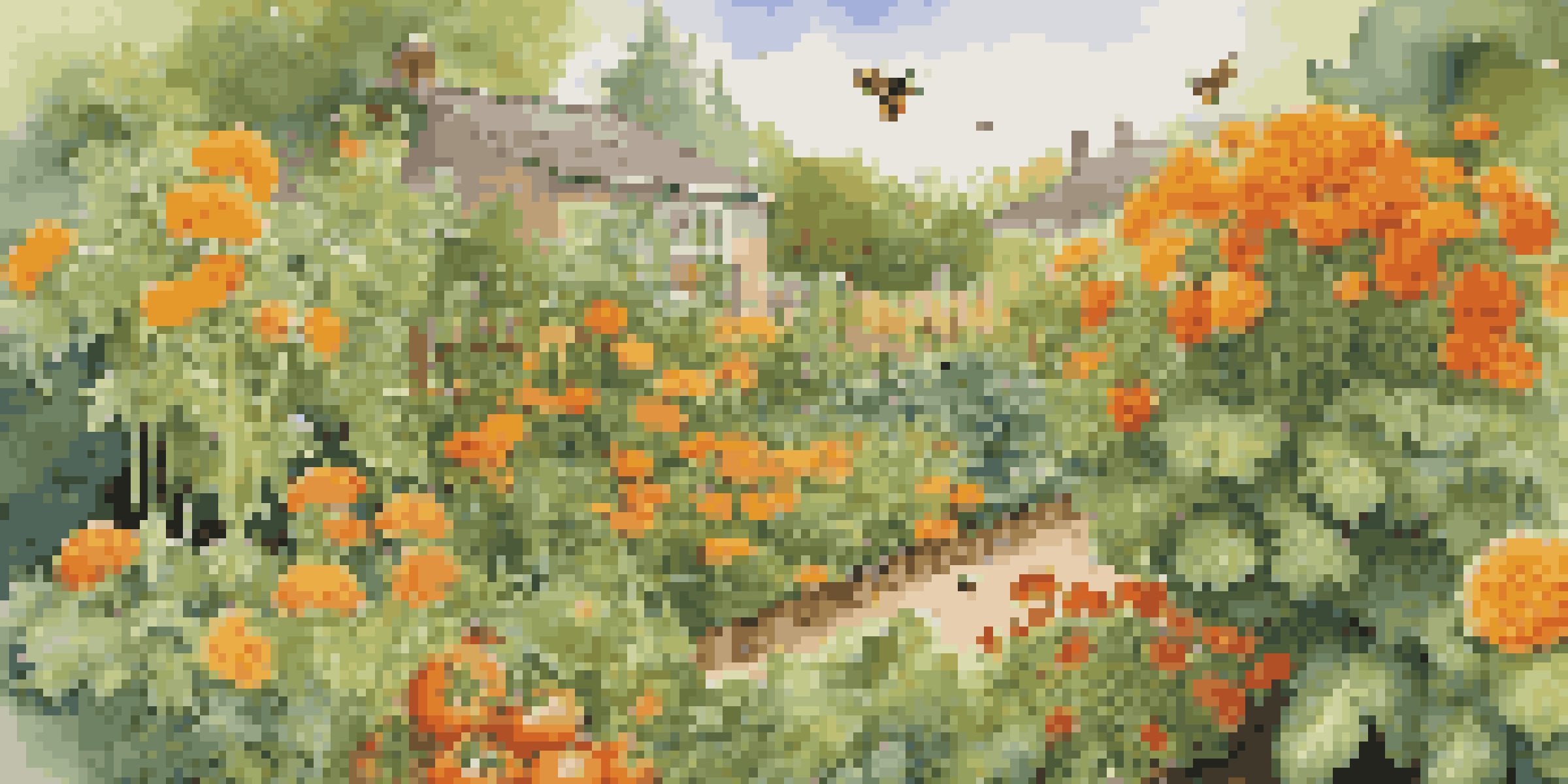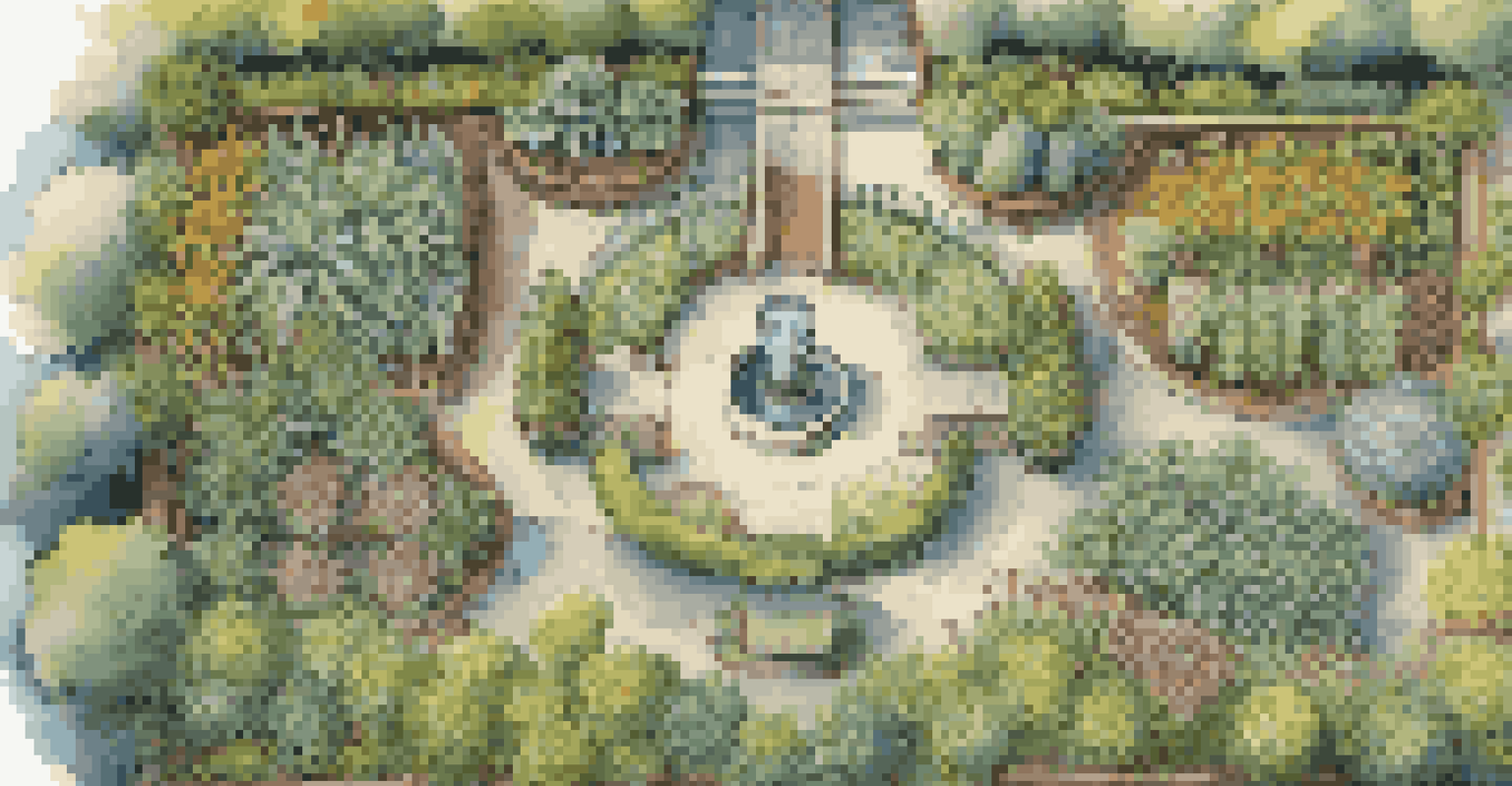The Benefits of Companion Planting: Natural Pest Management Tips

Understanding Companion Planting and Its Benefits
Companion planting is the practice of growing different plants together for mutual benefits. Imagine your garden as a bustling community where plants can support each other, much like friends do in our lives. This method can enhance growth, deter pests, and improve overall garden health.
The garden suggests there might be a place where we can meet nature halfway.
By strategically placing plants that complement each other, you can create a natural ecosystem. For instance, pairing marigolds with vegetables can help ward off certain pests while attracting beneficial insects. This synergy not only boosts plant health but also reduces the need for chemical pesticides.
In addition to pest management, companion planting can enhance flavors and yields. For example, planting basil near tomatoes not only tastes great but also promotes a healthier tomato plant. This approach to gardening encourages biodiversity, making your garden more resilient.
How Companion Planting Aids in Pest Management
Companion planting acts as a natural pest deterrent in various ways. Certain plants emit scents that repel unwanted insects, while others attract beneficial predators like ladybugs and lacewings. By understanding these relationships, you can create an inviting environment for helpful creatures while keeping pests at bay.

For example, planting garlic around your vegetable garden can deter aphids and spider mites, providing a protective barrier. Similarly, nasturtiums can attract aphids away from your more valuable crops, acting as a trap plant. This not only minimizes pest damage but also promotes a healthier ecosystem.
Companion Planting Boosts Growth
By strategically pairing plants, you can enhance growth, deter pests, and improve overall garden health.
Moreover, the diversity created by companion planting can confuse pests, making it harder for them to locate their favorite food. This natural tactic reduces reliance on harmful chemicals, allowing your garden to flourish sustainably.
Choosing the Right Companion Plants
Selecting the right companion plants is crucial for maximizing benefits. Not all plants play well together, so it's essential to do a bit of research before planting. Think of it like choosing the right teammates for a game; compatibility is key for success.
To plant a garden is to believe in tomorrow.
Start by considering plants that naturally enhance each other's growth. For instance, beans add nitrogen to the soil, which can benefit heavy feeders like corn. On the other hand, certain herbs can repel pests while also providing culinary benefits.
Additionally, pay attention to growth habits and needs. For example, tall plants can shade shorter ones, creating a microclimate that benefits both. By carefully choosing companions, you can create a thriving garden that works together harmoniously.
Building a Pest-Resistant Garden with Companion Planting
To build a pest-resistant garden, start by mapping out your planting layout. Consider grouping plants that benefit each other close together, creating a natural barrier against pests. This strategic approach can significantly reduce pest populations before they become a problem.
Incorporate a variety of plants to enhance biodiversity, which is crucial for a healthy garden. Diverse plant life attracts a range of beneficial insects and creates a balanced ecosystem. Think of your garden as a vibrant tapestry, where each thread contributes to the overall beauty and function.
Pest Management Through Diversity
Companion planting creates a diverse ecosystem that naturally confuses pests and attracts beneficial insects.
Regular observation is also vital. Keep an eye on plant health and pest activity, adjusting your companion planting strategy as needed. This hands-on approach allows you to learn what works best in your specific environment, ensuring long-term pest management success.
The Role of Flowers in Companion Planting
Including flowers in your companion planting scheme can enhance not just beauty but also pest management. Many flowering plants attract beneficial insects, such as pollinators and predatory species that feed on pests. Think of flowers as the life of the party, drawing in guests who help keep unwanted attendees away.
For example, planting yarrow or dill can attract ladybugs, which feast on aphids. Meanwhile, colorful zinnias can draw in bees and butterflies, promoting pollination across your garden. This not only aids pest control but also boosts your plants' productivity.
Furthermore, flowers can provide habitats for beneficial insects, allowing them to thrive in your garden. This creates a self-sustaining environment where natural pest control becomes the norm, reducing the need for artificial interventions.
Seasonal Considerations for Companion Planting
Timing is everything when it comes to companion planting. Different plants thrive in various seasons, so understanding their growth cycles is crucial. It's like planning a party; you want to ensure everyone arrives at the right time to enjoy the festivities together.
For example, you might plant cool-weather crops like lettuce and peas alongside radishes in early spring. As the seasons change, you can transition to warm-weather crops like tomatoes and peppers, pairing them with basil or marigolds. This seasonal rotation helps maintain soil health while maximizing pest control benefits.
Avoid Common Planting Mistakes
Overcrowding plants and ignoring compatibility can hinder growth, so proper research and maintenance are essential.
Additionally, consider the lifespan of your plants. Some, like annuals, complete their life cycle in one season, while perennials return year after year. By mixing these types, you can create a dynamic garden that adapts with the seasons, ensuring ongoing pest management success.
Common Mistakes in Companion Planting to Avoid
While companion planting can be highly effective, there are common pitfalls to avoid. One major mistake is overcrowding plants, which can lead to competition for nutrients and space. Just like in any close-knit community, too many members can create tension and hinder growth.
Another common error is ignoring plant compatibility. Certain plants, like onions and beans, can negatively affect each other's growth. It’s essential to research and understand which combinations work well together to avoid harming your garden's potential.

Lastly, neglecting maintenance can undermine your efforts. Regularly check for pests and plant health, adjusting your strategy as necessary. This proactive approach will help ensure your companion planting efforts yield the best results.